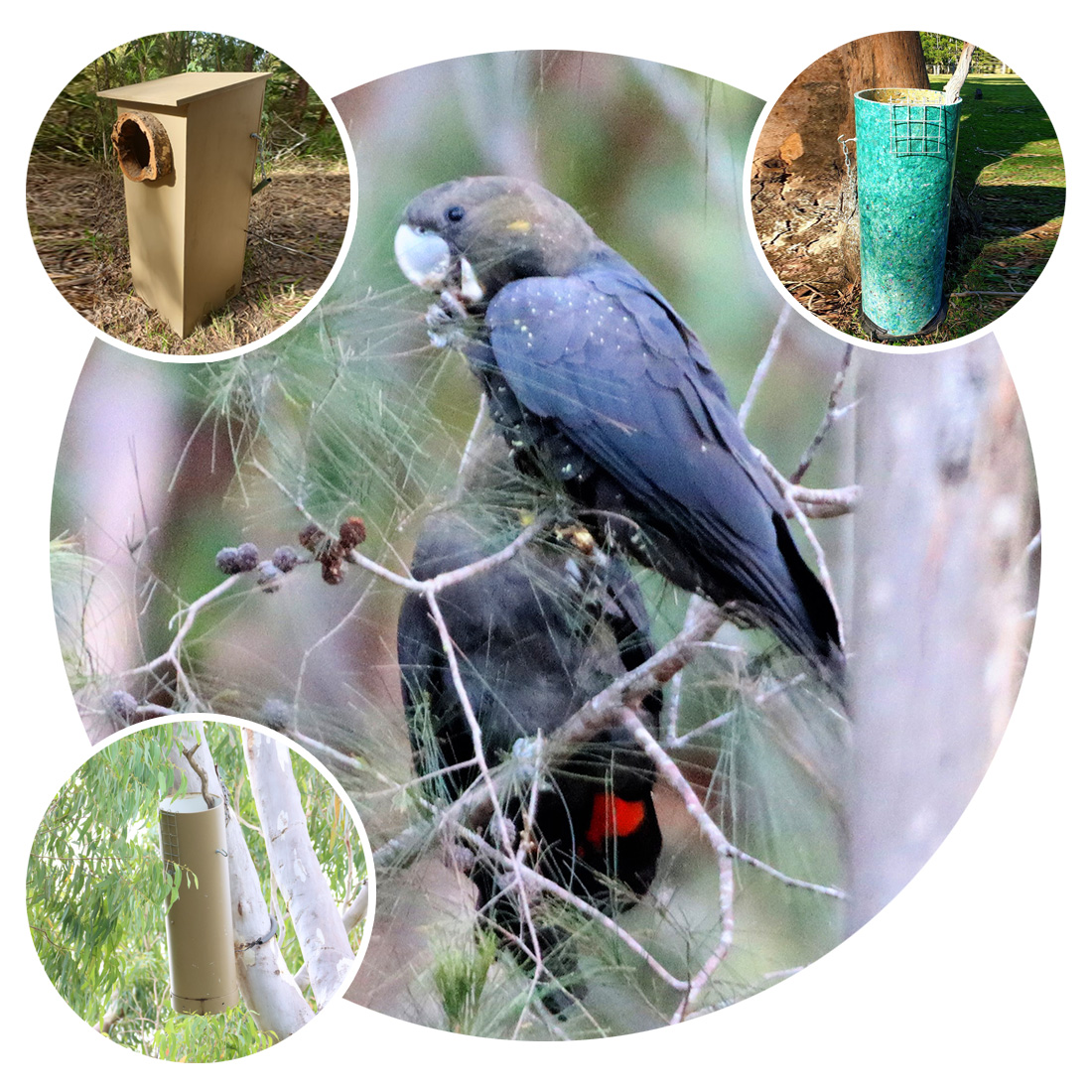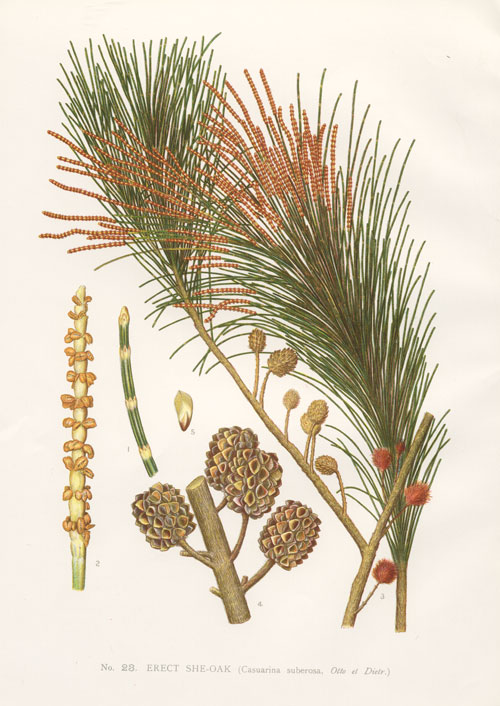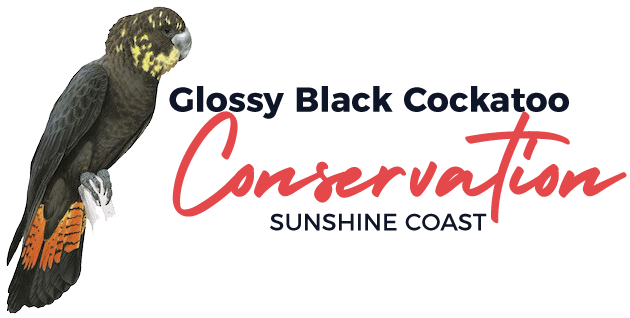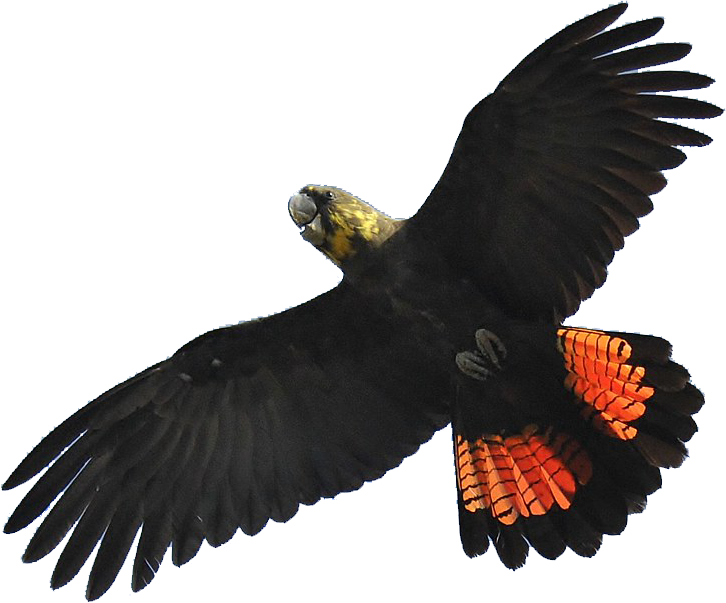What We Do
The project team at Bushland Conservation Management started on the Glossy Black Cockatoo Conservation project in 2022, focused on nesting ecology with bioacoustic technology in Noosa and the surrounding area.
The Bushland Conservation Management team travel across the Noosa and Sunshine Coast regions from early in the breeding season. We deploy Bioacoustic sound recorders across varying bushland habitat, with data retrieval we utilise Raven software and a call recogniser developed by Dr. Daniella Teixeira.
The Glossy Black Cockatoo is a rare and threatened species here in South East QLD and is listed as vulnerable and we need your help to help save this threatened species!
A key challenge in the Glossy Black Cockatoo recovery is breeding success. Pressures have been put on these large hollow dependant species by land clearing, logging, bush fires and fragmentation. The 2019 and 2020 bushfires in Peregian Springs and Cooroibah impacted feed tree sites and habitat trees in the Noosa Shire with She-Oak feed trees taking up to several years to be of seed producing viability for the birds again.
These beautiful cockatoos are in decline due to nesting requirements as well as their specialised feeding requirements, predominately feeding on the She-oak Allocasuarina littoralis and A.torulosa. They do not feed in pine trees or eat any other seed.
Minimal data collection has been recorded in South East Queensland on the GBC in regards to bird populations and nesting ecology, including identifying current natural nesting hollows and feed trees. This data will help facilitate the conservation of viable populations of the Glossy Black Cockatoo and their habitats across the Noosa and Sunshine Coast region.
The use of sound recordings and visual monitoring makes this project very low impact on the birds.
Visual monitoring, feed tree recording, watering site, roosting site records, flight path and research into the effects and recovery time of known feed sites after bushfire. Initiation of further feed tree plantings and nest box installations across the Noosa and Sunshine Coast Council regions.
Nest sites recorded will have better conservation efforts targeted in those key areas including better predator protection of the nest site such as collaring the base of tree, removal of connecting canopy to deter predators, weed management, and feed tree planting revegetation initiated.
The Glossy Black Cockatoo (GBC) Calyptorhynchus lathami lathami is the smallest of the black cockatoos. They can sometimes be confused with the similar but larger Red-Tailed Black Cockatoo (which are less common to be seen in this region here on the Sunshine Coast, also having showy red tail feathers), or the beautiful, cheeky and noisy Yellow-Tailed Black Cockatoo.
The GBC is a rare and threatened species here in South East QLD and is listed as vulnerable and we need your help to save this threatened species!

Nesting Boxes for Glossy Black Cockatoos
Bushland Conservation Management have a range of nesting boxes built specifically for the Glossy Black Cockatoo, to help aid the conservation of the species.
All nest boxes have a large chewing branch to aid in chewing and beak development, a ladder and a mulch layer at the base and excellent drainage holes at the base of the boxes/hollows.
Installation of these nesting boxes in GBC habitat is vital to help promote their survival.
Bioacoustic Sound Recording
Our project utilises bioacoustic sound recorders with software to monitor and analyse calls of the Glossy Black-Cockatoo. Identifying successful nesting sites will enable better support and conservation management for local Glossy populations.
This research can inform feed tree revegetation, watering hole rehabilitation, habitat protection and further nesting box installation in identified Glossy Black Cockatoo critical zones.
Bioacoustic sound recording software was developed by Dr Daniella Teixeira and has been successfully used in other parts of the country, in particular on Kangaroo Island.
How YOU Can Help!

PLEASE SUBMIT A SIGHTING!
No information is too little or insignificant.
Keep an eye on your local large hollows and submit a sighting if you see a GBC near hollows
- Feeding activity
- Drinking sites
- Roost sites
- Flight direction
- Time of day
- All important
Please retain Allocasuarina on your property remembering that the desired seed maturity after burns or clearing can take from 7 to 20 years for the birds to return.
Plant trees! Please plant for the Noosa and Sunshine Coast region Allocasuarina littoralis (Black She Oak found in Wallum/Coastal/Eucalypt forest -(Forest She Oak) Allocasuarina torulosa Found in Eucalypt forest on slopes, hills and mountains. – Casuarina equisetfolia (Coastal SheOak )

